Evaluating the Fed's Operation Twist and Quantitative Easing
VerifiedAdded on 2023/04/24
|8
|1910
|389
Essay
AI Summary
This essay provides a comprehensive analysis of the U.S. economic system, focusing on the immediate causes of the 2008 recession and the subsequent corrective measures undertaken by the U.S. government, specifically the implementation of Operation Twist and Quantitative Easing (QE). It evaluates the effectiveness of these government interventions, highlighting the role of QE1 and QE2 in stimulating the economy and preventing a deeper recession impact from the subprime mortgage crisis. The essay also discusses the nuances of Operation Twist, its intended effects on short-term and long-term interest rates, and its limitations due to high investor demand for short-term treasuries. It further elaborates on the potential inflationary risks associated with quantitative easing and contrasts it with the reduced risk of inflation overshooting associated with Operation Twist, ultimately assessing the overall impact of these policies on economic recovery.
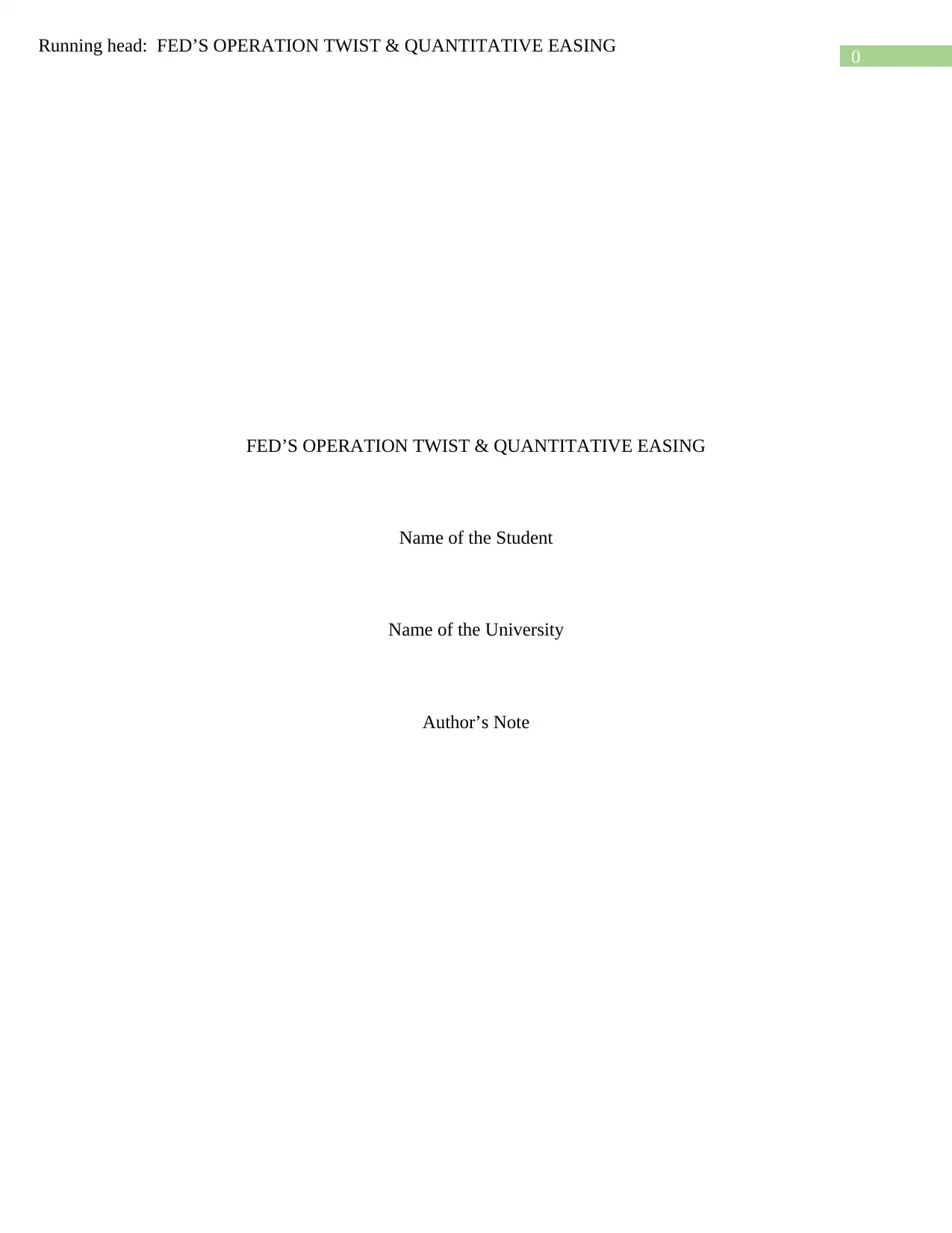
0
Running head: FED’S OPERATION TWIST & QUANTITATIVE EASING
FED’S OPERATION TWIST & QUANTITATIVE EASING
Name of the Student
Name of the University
Author’s Note
Running head: FED’S OPERATION TWIST & QUANTITATIVE EASING
FED’S OPERATION TWIST & QUANTITATIVE EASING
Name of the Student
Name of the University
Author’s Note
Paraphrase This Document
Need a fresh take? Get an instant paraphrase of this document with our AI Paraphraser
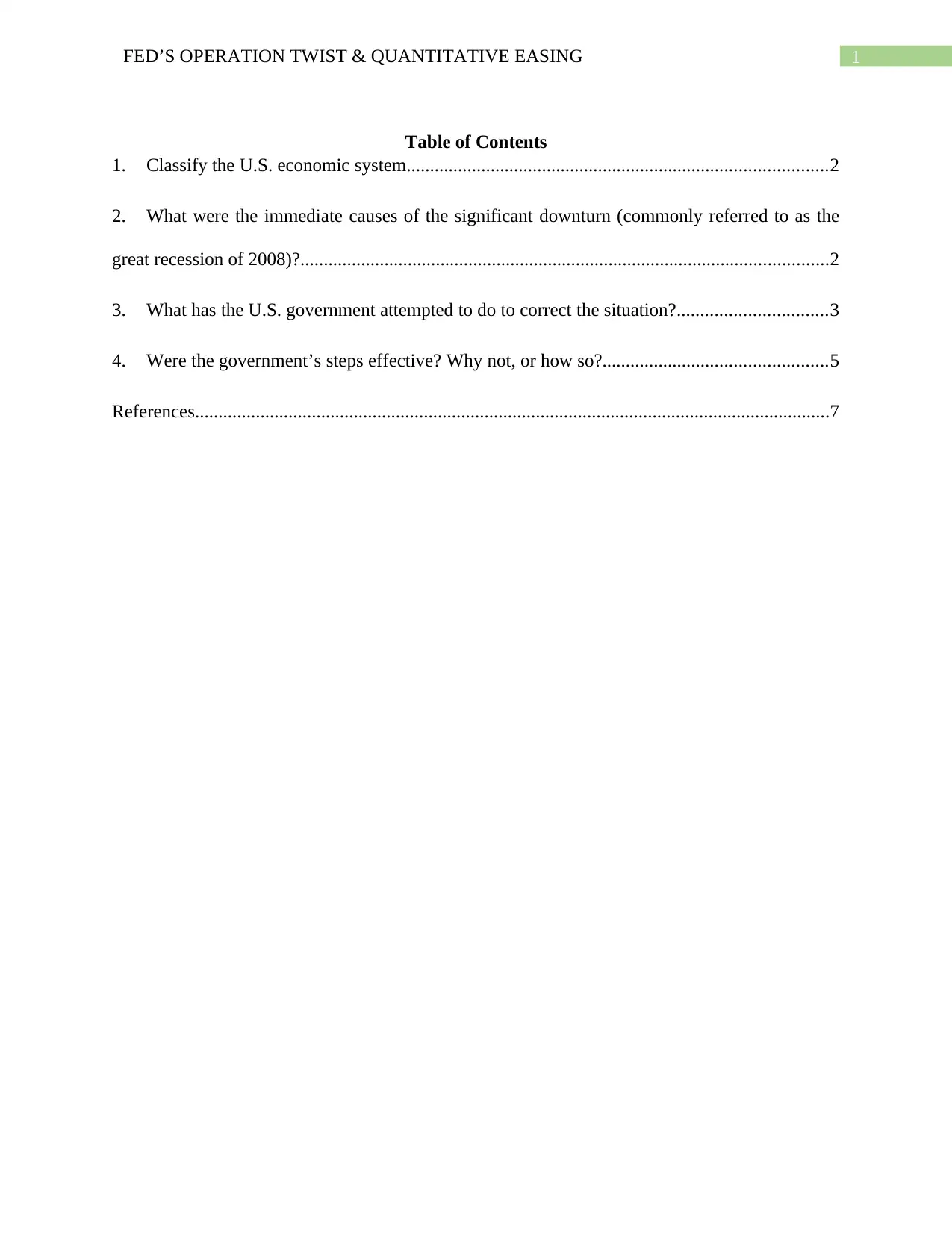
1FED’S OPERATION TWIST & QUANTITATIVE EASING
Table of Contents
1. Classify the U.S. economic system..........................................................................................2
2. What were the immediate causes of the significant downturn (commonly referred to as the
great recession of 2008)?.................................................................................................................2
3. What has the U.S. government attempted to do to correct the situation?................................3
4. Were the government’s steps effective? Why not, or how so?................................................5
References........................................................................................................................................7
Table of Contents
1. Classify the U.S. economic system..........................................................................................2
2. What were the immediate causes of the significant downturn (commonly referred to as the
great recession of 2008)?.................................................................................................................2
3. What has the U.S. government attempted to do to correct the situation?................................3
4. Were the government’s steps effective? Why not, or how so?................................................5
References........................................................................................................................................7
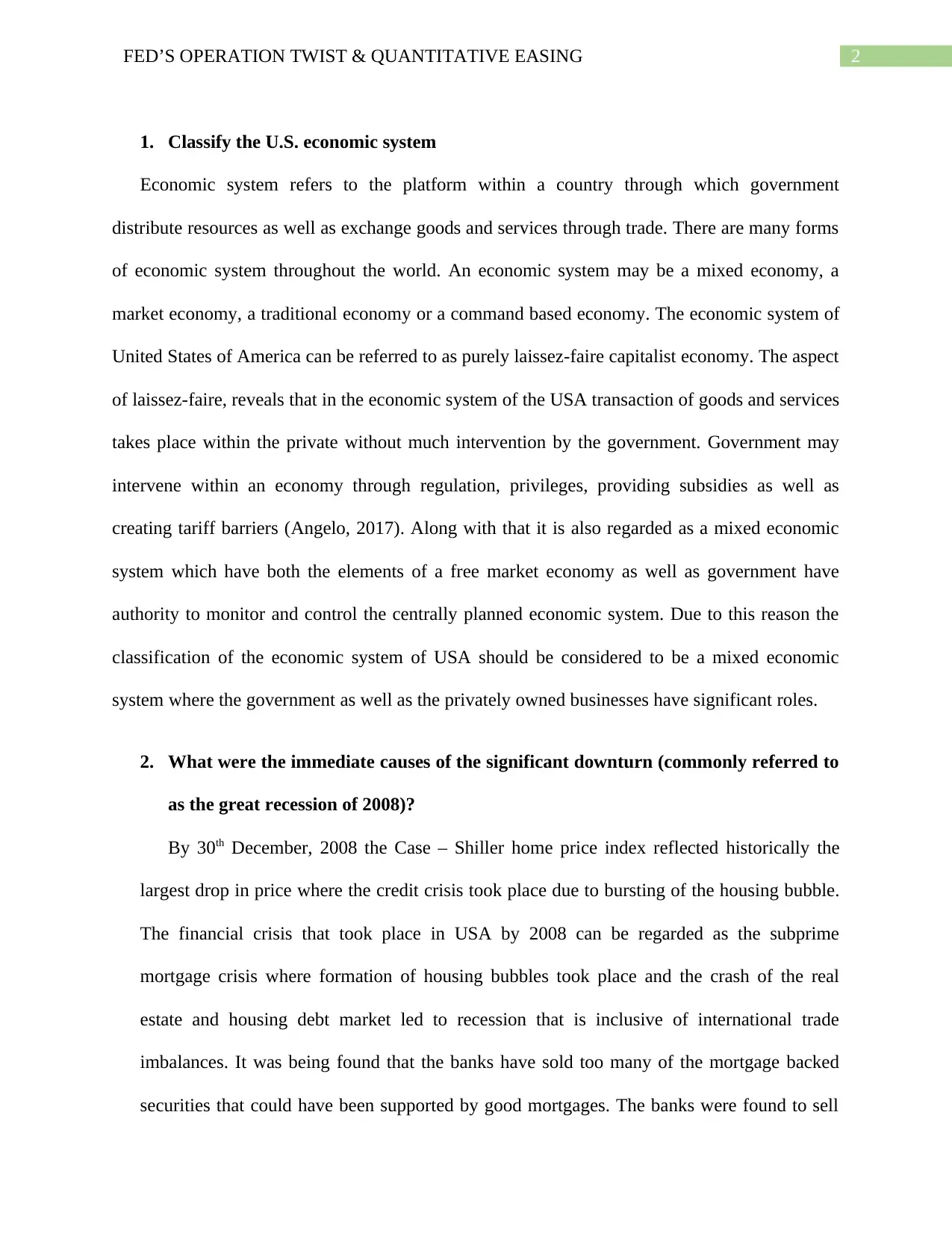
2FED’S OPERATION TWIST & QUANTITATIVE EASING
1. Classify the U.S. economic system
Economic system refers to the platform within a country through which government
distribute resources as well as exchange goods and services through trade. There are many forms
of economic system throughout the world. An economic system may be a mixed economy, a
market economy, a traditional economy or a command based economy. The economic system of
United States of America can be referred to as purely laissez-faire capitalist economy. The aspect
of laissez-faire, reveals that in the economic system of the USA transaction of goods and services
takes place within the private without much intervention by the government. Government may
intervene within an economy through regulation, privileges, providing subsidies as well as
creating tariff barriers (Angelo, 2017). Along with that it is also regarded as a mixed economic
system which have both the elements of a free market economy as well as government have
authority to monitor and control the centrally planned economic system. Due to this reason the
classification of the economic system of USA should be considered to be a mixed economic
system where the government as well as the privately owned businesses have significant roles.
2. What were the immediate causes of the significant downturn (commonly referred to
as the great recession of 2008)?
By 30th December, 2008 the Case – Shiller home price index reflected historically the
largest drop in price where the credit crisis took place due to bursting of the housing bubble.
The financial crisis that took place in USA by 2008 can be regarded as the subprime
mortgage crisis where formation of housing bubbles took place and the crash of the real
estate and housing debt market led to recession that is inclusive of international trade
imbalances. It was being found that the banks have sold too many of the mortgage backed
securities that could have been supported by good mortgages. The banks were found to sell
1. Classify the U.S. economic system
Economic system refers to the platform within a country through which government
distribute resources as well as exchange goods and services through trade. There are many forms
of economic system throughout the world. An economic system may be a mixed economy, a
market economy, a traditional economy or a command based economy. The economic system of
United States of America can be referred to as purely laissez-faire capitalist economy. The aspect
of laissez-faire, reveals that in the economic system of the USA transaction of goods and services
takes place within the private without much intervention by the government. Government may
intervene within an economy through regulation, privileges, providing subsidies as well as
creating tariff barriers (Angelo, 2017). Along with that it is also regarded as a mixed economic
system which have both the elements of a free market economy as well as government have
authority to monitor and control the centrally planned economic system. Due to this reason the
classification of the economic system of USA should be considered to be a mixed economic
system where the government as well as the privately owned businesses have significant roles.
2. What were the immediate causes of the significant downturn (commonly referred to
as the great recession of 2008)?
By 30th December, 2008 the Case – Shiller home price index reflected historically the
largest drop in price where the credit crisis took place due to bursting of the housing bubble.
The financial crisis that took place in USA by 2008 can be regarded as the subprime
mortgage crisis where formation of housing bubbles took place and the crash of the real
estate and housing debt market led to recession that is inclusive of international trade
imbalances. It was being found that the banks have sold too many of the mortgage backed
securities that could have been supported by good mortgages. The banks were found to sell
⊘ This is a preview!⊘
Do you want full access?
Subscribe today to unlock all pages.

Trusted by 1+ million students worldwide
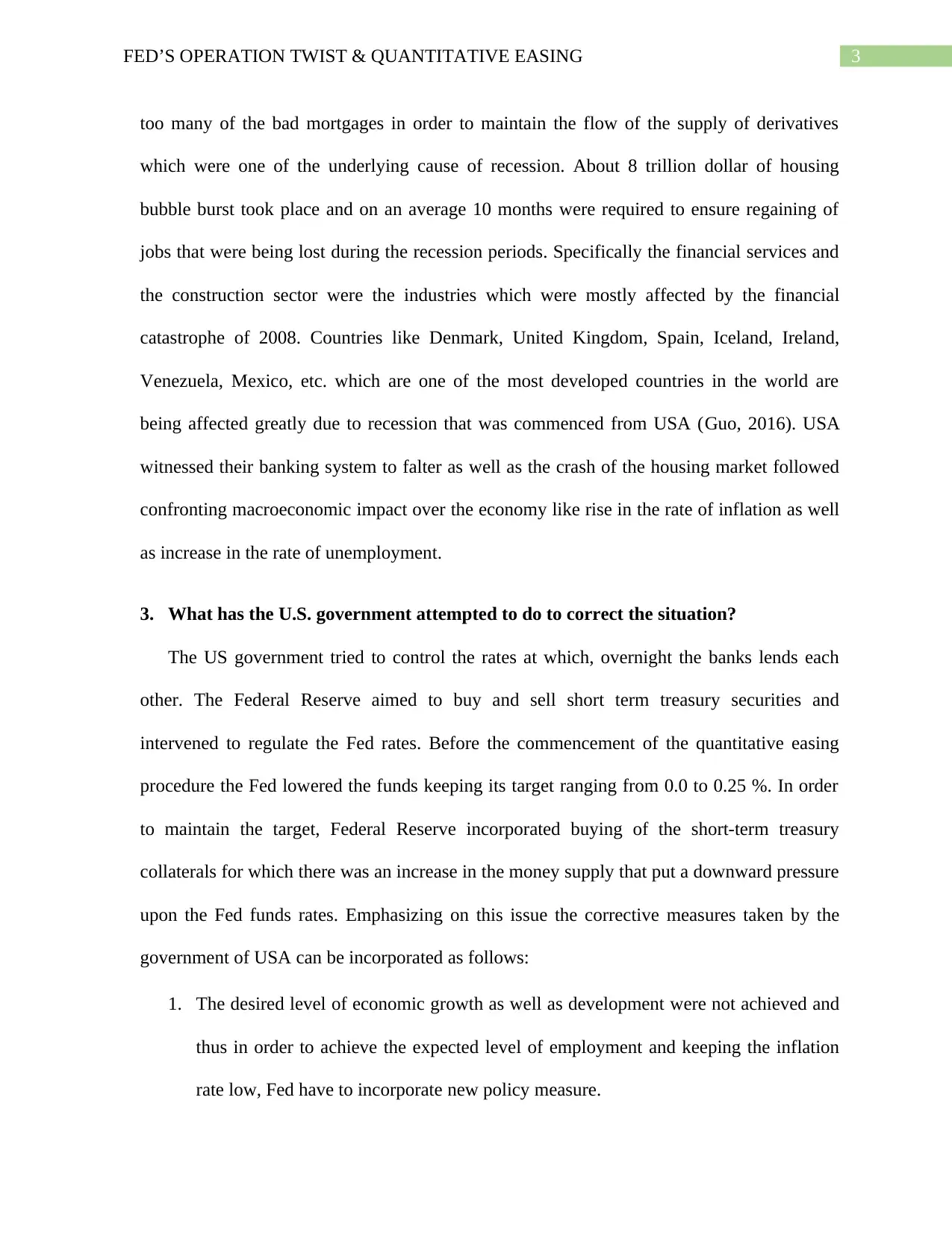
3FED’S OPERATION TWIST & QUANTITATIVE EASING
too many of the bad mortgages in order to maintain the flow of the supply of derivatives
which were one of the underlying cause of recession. About 8 trillion dollar of housing
bubble burst took place and on an average 10 months were required to ensure regaining of
jobs that were being lost during the recession periods. Specifically the financial services and
the construction sector were the industries which were mostly affected by the financial
catastrophe of 2008. Countries like Denmark, United Kingdom, Spain, Iceland, Ireland,
Venezuela, Mexico, etc. which are one of the most developed countries in the world are
being affected greatly due to recession that was commenced from USA (Guo, 2016). USA
witnessed their banking system to falter as well as the crash of the housing market followed
confronting macroeconomic impact over the economy like rise in the rate of inflation as well
as increase in the rate of unemployment.
3. What has the U.S. government attempted to do to correct the situation?
The US government tried to control the rates at which, overnight the banks lends each
other. The Federal Reserve aimed to buy and sell short term treasury securities and
intervened to regulate the Fed rates. Before the commencement of the quantitative easing
procedure the Fed lowered the funds keeping its target ranging from 0.0 to 0.25 %. In order
to maintain the target, Federal Reserve incorporated buying of the short-term treasury
collaterals for which there was an increase in the money supply that put a downward pressure
upon the Fed funds rates. Emphasizing on this issue the corrective measures taken by the
government of USA can be incorporated as follows:
1. The desired level of economic growth as well as development were not achieved and
thus in order to achieve the expected level of employment and keeping the inflation
rate low, Fed have to incorporate new policy measure.
too many of the bad mortgages in order to maintain the flow of the supply of derivatives
which were one of the underlying cause of recession. About 8 trillion dollar of housing
bubble burst took place and on an average 10 months were required to ensure regaining of
jobs that were being lost during the recession periods. Specifically the financial services and
the construction sector were the industries which were mostly affected by the financial
catastrophe of 2008. Countries like Denmark, United Kingdom, Spain, Iceland, Ireland,
Venezuela, Mexico, etc. which are one of the most developed countries in the world are
being affected greatly due to recession that was commenced from USA (Guo, 2016). USA
witnessed their banking system to falter as well as the crash of the housing market followed
confronting macroeconomic impact over the economy like rise in the rate of inflation as well
as increase in the rate of unemployment.
3. What has the U.S. government attempted to do to correct the situation?
The US government tried to control the rates at which, overnight the banks lends each
other. The Federal Reserve aimed to buy and sell short term treasury securities and
intervened to regulate the Fed rates. Before the commencement of the quantitative easing
procedure the Fed lowered the funds keeping its target ranging from 0.0 to 0.25 %. In order
to maintain the target, Federal Reserve incorporated buying of the short-term treasury
collaterals for which there was an increase in the money supply that put a downward pressure
upon the Fed funds rates. Emphasizing on this issue the corrective measures taken by the
government of USA can be incorporated as follows:
1. The desired level of economic growth as well as development were not achieved and
thus in order to achieve the expected level of employment and keeping the inflation
rate low, Fed have to incorporate new policy measure.
Paraphrase This Document
Need a fresh take? Get an instant paraphrase of this document with our AI Paraphraser
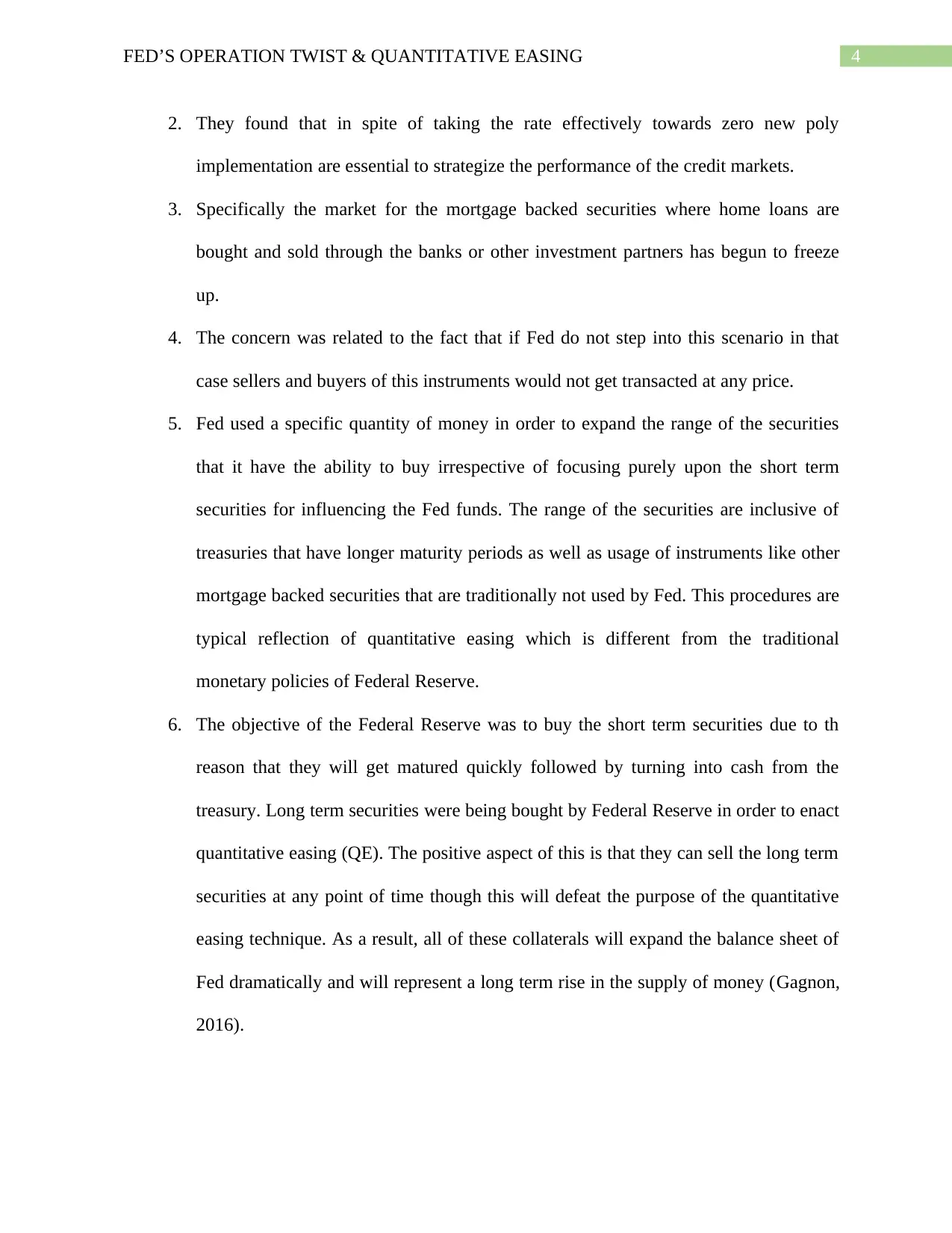
4FED’S OPERATION TWIST & QUANTITATIVE EASING
2. They found that in spite of taking the rate effectively towards zero new poly
implementation are essential to strategize the performance of the credit markets.
3. Specifically the market for the mortgage backed securities where home loans are
bought and sold through the banks or other investment partners has begun to freeze
up.
4. The concern was related to the fact that if Fed do not step into this scenario in that
case sellers and buyers of this instruments would not get transacted at any price.
5. Fed used a specific quantity of money in order to expand the range of the securities
that it have the ability to buy irrespective of focusing purely upon the short term
securities for influencing the Fed funds. The range of the securities are inclusive of
treasuries that have longer maturity periods as well as usage of instruments like other
mortgage backed securities that are traditionally not used by Fed. This procedures are
typical reflection of quantitative easing which is different from the traditional
monetary policies of Federal Reserve.
6. The objective of the Federal Reserve was to buy the short term securities due to th
reason that they will get matured quickly followed by turning into cash from the
treasury. Long term securities were being bought by Federal Reserve in order to enact
quantitative easing (QE). The positive aspect of this is that they can sell the long term
securities at any point of time though this will defeat the purpose of the quantitative
easing technique. As a result, all of these collaterals will expand the balance sheet of
Fed dramatically and will represent a long term rise in the supply of money (Gagnon,
2016).
2. They found that in spite of taking the rate effectively towards zero new poly
implementation are essential to strategize the performance of the credit markets.
3. Specifically the market for the mortgage backed securities where home loans are
bought and sold through the banks or other investment partners has begun to freeze
up.
4. The concern was related to the fact that if Fed do not step into this scenario in that
case sellers and buyers of this instruments would not get transacted at any price.
5. Fed used a specific quantity of money in order to expand the range of the securities
that it have the ability to buy irrespective of focusing purely upon the short term
securities for influencing the Fed funds. The range of the securities are inclusive of
treasuries that have longer maturity periods as well as usage of instruments like other
mortgage backed securities that are traditionally not used by Fed. This procedures are
typical reflection of quantitative easing which is different from the traditional
monetary policies of Federal Reserve.
6. The objective of the Federal Reserve was to buy the short term securities due to th
reason that they will get matured quickly followed by turning into cash from the
treasury. Long term securities were being bought by Federal Reserve in order to enact
quantitative easing (QE). The positive aspect of this is that they can sell the long term
securities at any point of time though this will defeat the purpose of the quantitative
easing technique. As a result, all of these collaterals will expand the balance sheet of
Fed dramatically and will represent a long term rise in the supply of money (Gagnon,
2016).
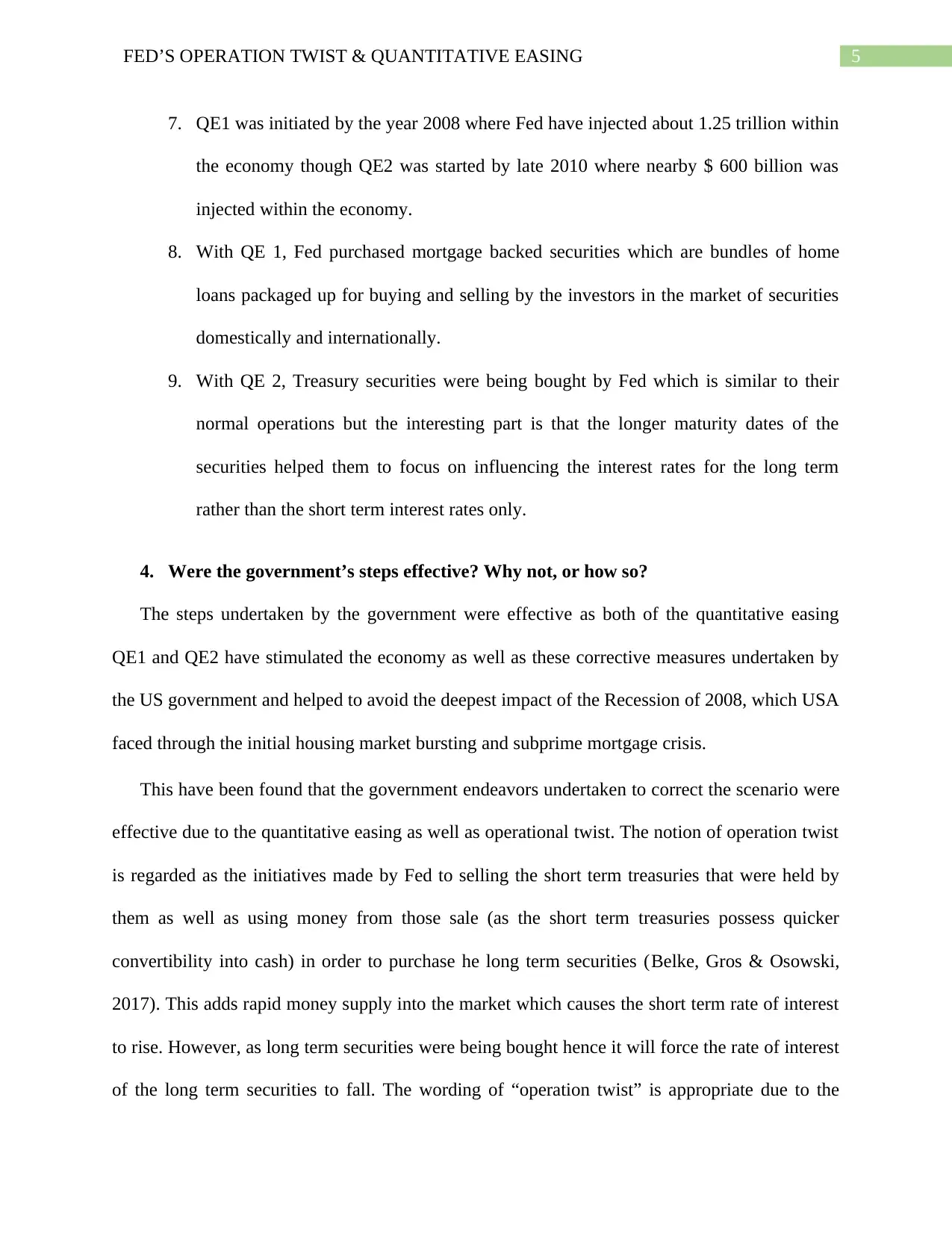
5FED’S OPERATION TWIST & QUANTITATIVE EASING
7. QE1 was initiated by the year 2008 where Fed have injected about 1.25 trillion within
the economy though QE2 was started by late 2010 where nearby $ 600 billion was
injected within the economy.
8. With QE 1, Fed purchased mortgage backed securities which are bundles of home
loans packaged up for buying and selling by the investors in the market of securities
domestically and internationally.
9. With QE 2, Treasury securities were being bought by Fed which is similar to their
normal operations but the interesting part is that the longer maturity dates of the
securities helped them to focus on influencing the interest rates for the long term
rather than the short term interest rates only.
4. Were the government’s steps effective? Why not, or how so?
The steps undertaken by the government were effective as both of the quantitative easing
QE1 and QE2 have stimulated the economy as well as these corrective measures undertaken by
the US government and helped to avoid the deepest impact of the Recession of 2008, which USA
faced through the initial housing market bursting and subprime mortgage crisis.
This have been found that the government endeavors undertaken to correct the scenario were
effective due to the quantitative easing as well as operational twist. The notion of operation twist
is regarded as the initiatives made by Fed to selling the short term treasuries that were held by
them as well as using money from those sale (as the short term treasuries possess quicker
convertibility into cash) in order to purchase he long term securities (Belke, Gros & Osowski,
2017). This adds rapid money supply into the market which causes the short term rate of interest
to rise. However, as long term securities were being bought hence it will force the rate of interest
of the long term securities to fall. The wording of “operation twist” is appropriate due to the
7. QE1 was initiated by the year 2008 where Fed have injected about 1.25 trillion within
the economy though QE2 was started by late 2010 where nearby $ 600 billion was
injected within the economy.
8. With QE 1, Fed purchased mortgage backed securities which are bundles of home
loans packaged up for buying and selling by the investors in the market of securities
domestically and internationally.
9. With QE 2, Treasury securities were being bought by Fed which is similar to their
normal operations but the interesting part is that the longer maturity dates of the
securities helped them to focus on influencing the interest rates for the long term
rather than the short term interest rates only.
4. Were the government’s steps effective? Why not, or how so?
The steps undertaken by the government were effective as both of the quantitative easing
QE1 and QE2 have stimulated the economy as well as these corrective measures undertaken by
the US government and helped to avoid the deepest impact of the Recession of 2008, which USA
faced through the initial housing market bursting and subprime mortgage crisis.
This have been found that the government endeavors undertaken to correct the scenario were
effective due to the quantitative easing as well as operational twist. The notion of operation twist
is regarded as the initiatives made by Fed to selling the short term treasuries that were held by
them as well as using money from those sale (as the short term treasuries possess quicker
convertibility into cash) in order to purchase he long term securities (Belke, Gros & Osowski,
2017). This adds rapid money supply into the market which causes the short term rate of interest
to rise. However, as long term securities were being bought hence it will force the rate of interest
of the long term securities to fall. The wording of “operation twist” is appropriate due to the
⊘ This is a preview!⊘
Do you want full access?
Subscribe today to unlock all pages.

Trusted by 1+ million students worldwide
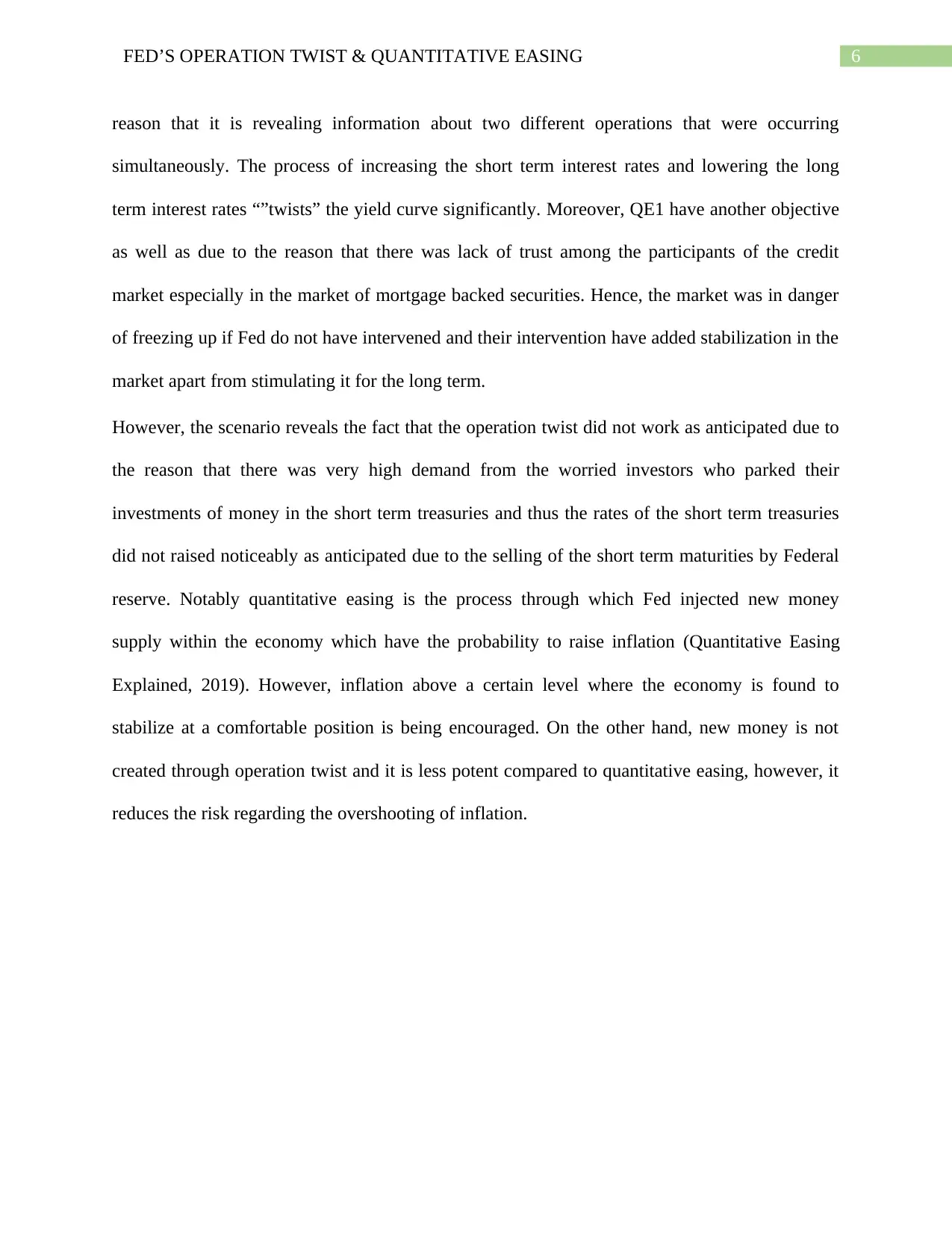
6FED’S OPERATION TWIST & QUANTITATIVE EASING
reason that it is revealing information about two different operations that were occurring
simultaneously. The process of increasing the short term interest rates and lowering the long
term interest rates “”twists” the yield curve significantly. Moreover, QE1 have another objective
as well as due to the reason that there was lack of trust among the participants of the credit
market especially in the market of mortgage backed securities. Hence, the market was in danger
of freezing up if Fed do not have intervened and their intervention have added stabilization in the
market apart from stimulating it for the long term.
However, the scenario reveals the fact that the operation twist did not work as anticipated due to
the reason that there was very high demand from the worried investors who parked their
investments of money in the short term treasuries and thus the rates of the short term treasuries
did not raised noticeably as anticipated due to the selling of the short term maturities by Federal
reserve. Notably quantitative easing is the process through which Fed injected new money
supply within the economy which have the probability to raise inflation (Quantitative Easing
Explained, 2019). However, inflation above a certain level where the economy is found to
stabilize at a comfortable position is being encouraged. On the other hand, new money is not
created through operation twist and it is less potent compared to quantitative easing, however, it
reduces the risk regarding the overshooting of inflation.
reason that it is revealing information about two different operations that were occurring
simultaneously. The process of increasing the short term interest rates and lowering the long
term interest rates “”twists” the yield curve significantly. Moreover, QE1 have another objective
as well as due to the reason that there was lack of trust among the participants of the credit
market especially in the market of mortgage backed securities. Hence, the market was in danger
of freezing up if Fed do not have intervened and their intervention have added stabilization in the
market apart from stimulating it for the long term.
However, the scenario reveals the fact that the operation twist did not work as anticipated due to
the reason that there was very high demand from the worried investors who parked their
investments of money in the short term treasuries and thus the rates of the short term treasuries
did not raised noticeably as anticipated due to the selling of the short term maturities by Federal
reserve. Notably quantitative easing is the process through which Fed injected new money
supply within the economy which have the probability to raise inflation (Quantitative Easing
Explained, 2019). However, inflation above a certain level where the economy is found to
stabilize at a comfortable position is being encouraged. On the other hand, new money is not
created through operation twist and it is less potent compared to quantitative easing, however, it
reduces the risk regarding the overshooting of inflation.
Paraphrase This Document
Need a fresh take? Get an instant paraphrase of this document with our AI Paraphraser
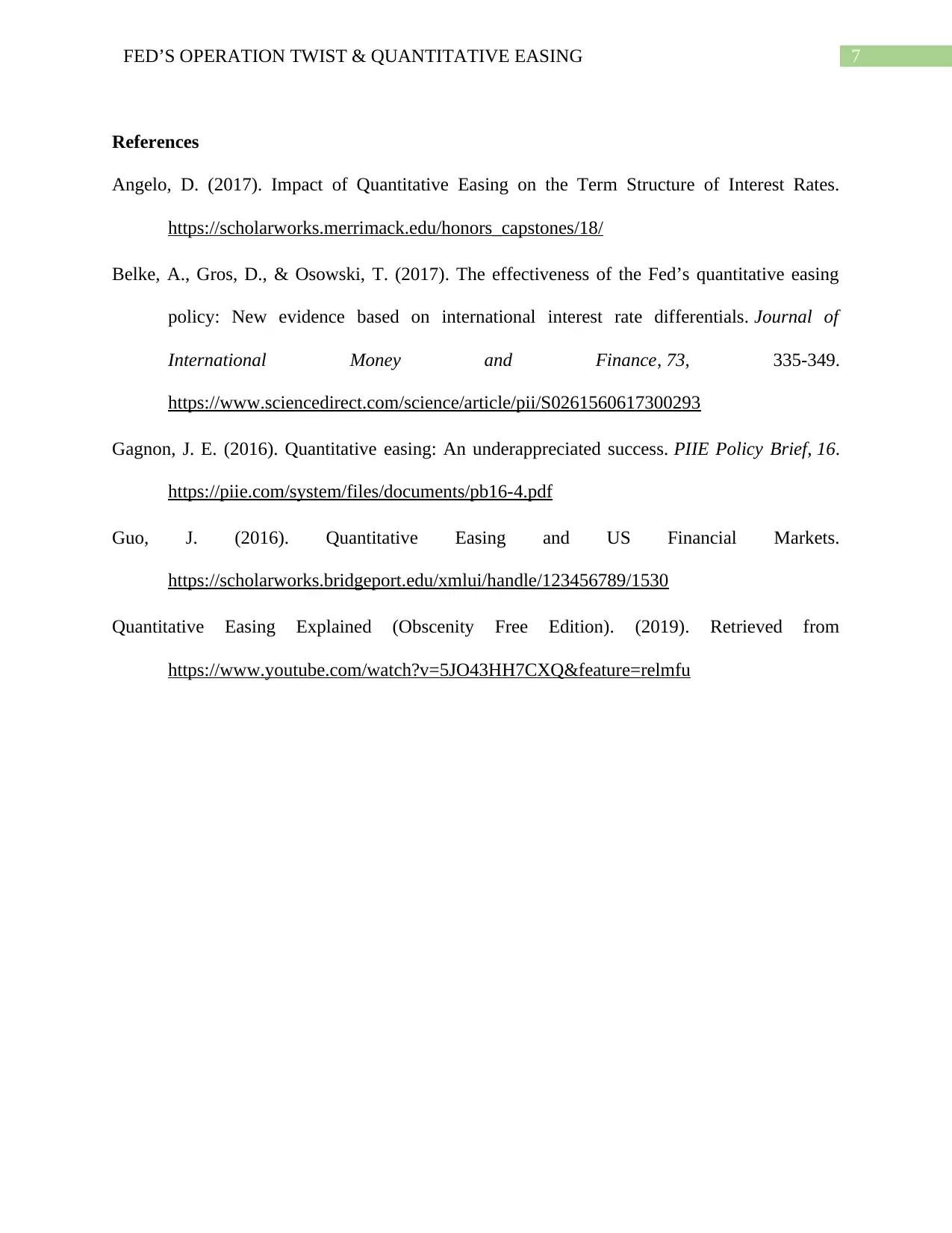
7FED’S OPERATION TWIST & QUANTITATIVE EASING
References
Angelo, D. (2017). Impact of Quantitative Easing on the Term Structure of Interest Rates.
https://scholarworks.merrimack.edu/honors_capstones/18/
Belke, A., Gros, D., & Osowski, T. (2017). The effectiveness of the Fed’s quantitative easing
policy: New evidence based on international interest rate differentials. Journal of
International Money and Finance, 73, 335-349.
https://www.sciencedirect.com/science/article/pii/S0261560617300293
Gagnon, J. E. (2016). Quantitative easing: An underappreciated success. PIIE Policy Brief, 16.
https://piie.com/system/files/documents/pb16-4.pdf
Guo, J. (2016). Quantitative Easing and US Financial Markets.
https://scholarworks.bridgeport.edu/xmlui/handle/123456789/1530
Quantitative Easing Explained (Obscenity Free Edition). (2019). Retrieved from
https://www.youtube.com/watch?v=5JO43HH7CXQ&feature=relmfu
References
Angelo, D. (2017). Impact of Quantitative Easing on the Term Structure of Interest Rates.
https://scholarworks.merrimack.edu/honors_capstones/18/
Belke, A., Gros, D., & Osowski, T. (2017). The effectiveness of the Fed’s quantitative easing
policy: New evidence based on international interest rate differentials. Journal of
International Money and Finance, 73, 335-349.
https://www.sciencedirect.com/science/article/pii/S0261560617300293
Gagnon, J. E. (2016). Quantitative easing: An underappreciated success. PIIE Policy Brief, 16.
https://piie.com/system/files/documents/pb16-4.pdf
Guo, J. (2016). Quantitative Easing and US Financial Markets.
https://scholarworks.bridgeport.edu/xmlui/handle/123456789/1530
Quantitative Easing Explained (Obscenity Free Edition). (2019). Retrieved from
https://www.youtube.com/watch?v=5JO43HH7CXQ&feature=relmfu
1 out of 8
Related Documents
Your All-in-One AI-Powered Toolkit for Academic Success.
+13062052269
info@desklib.com
Available 24*7 on WhatsApp / Email
![[object Object]](/_next/static/media/star-bottom.7253800d.svg)
Unlock your academic potential
Copyright © 2020–2025 A2Z Services. All Rights Reserved. Developed and managed by ZUCOL.





